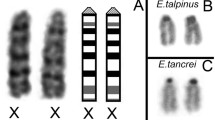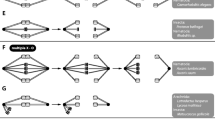Abstract
The X and Y chromosomes of the musk shrew are the two largest in the complement and they regularly form a single chiasma during meiosis. This chiasma is located in the short arms of the X and Y, both of which show partial C-banding at meiosis. The in vitro incorporation of 5-bromodeoxyuridine/tritiated thymidine during late S reveals that the non-C-band region of the Y finishes replication later than the C-band positive heterochromatin. During meiosis, the sex bivalent opens out early in pachytene to reveal a single chiasma which persists until late metaphase-I. In surface-spread, silver-stained meiocytes, the sex bivalent morphology changes from a phase of extensive pairing to one which includes a visible chiasma through a brief diffuse stage. Observations on C-banded meiocytes show a shift in the sex pair from a C-band positive to a negative state as compared to their corresponding somatic pattern. Comparable changes are also observed in the sex bivalents of other mammals which undergo a chiasmatic exchange. This suggests that in addition to pairing homology, an alteration in the chromatin configuration may be necessary for crossing over to occur between the sex chromosomes.
Similar content being viewed by others
References
Ando K, Tagawa T, Uchida TA (1980) C-banding pattern on the chromosome of the Japanese house shrew, Suncus murinus riukiuanus, and its implication. Experientia 36:1040–1041
Ashley T (1984) A re-examination of the cause for homology between the X and Y chromosomes of mouse and man. Hum Genet 67:372–377
Benirschke K (1968) The chromosome complement and meiosis of the North American porcupine. J Hered 59(1):71–76
Burgoyne PS (1982) Genetic homology and crossing over in the X and Y chromosomes of mammals. Hum Genet 61:85–90
De la Chapelle A, Tippett PA, Wetterstrand G, Page D (1984) Genetic evidence of X-Y interchange in a human XX male. Nature 307:170–171
Duncan JF, Van Peenen PFD, Rayan PF (1970) Somatic chromosomes of eight mammals from Con Son Island, South Vietnam. Caryologia 23:173–181
Fraccaro M, Gustavsson I, Hultén K, Lindsten J, Tiepolo L (1968) Chronology of DNA replication in the sex chromosomes of reindeer (Rangifer tarandus L.) Cytogenetics 7:196–211
Fraccaro M, Gustavsson I, Hultén M, Lindsten J, Tiepolo L (1969) Late replicating Y chromosome in spermatogonia of the Chinese hamster (Cricetulus griseus). Cytogenetics 8:263–271
Fredga K, Santesson B (1964) Male meiosis in the Syrian, Chinese, and European hamsters. Hereditas 52:36–48
Fredga K (1970) Unusual sex chromosome inheritance in mammals. Phil Trans R Soc Lond B259:15–36
Galton M, Benirschke K, Ohno S (1965) Sex chromosomes of the Chinchilla: Allocycly and duplication sequence in somatic cells and behaviour in meiosis. Chromosoma 16:668–680
Garel A, Axel R (1976) Selective digestion of transcriptionally active ovalbumin genes from oviduct nuclei. Proc Natl Acad Sci USA 73:3966–3970
Goto K, Akematsu T, Shimazu H, Sugiyama T (1975) Simple differential Giemsa staining of sister chromatids after treatment with photosensitive dyes and exposure to light and the mechanism of staining. Chromosoma 53:223–230
Hotta Y, Chandley AC (1982) Activities of X-linked enzymes in spermatocytes of mice rendered sterile by chromosomal alterations. Gam Res 6:65–72
Huang CC, Strong LC (1962) Chromosomes of the African mouse. J Hered 53:95–99
Lavappa KS, Yerganian G (1970) Spermatogonial and meiotic chromosome of the Armenian hamster, Cricetulus migratorius. Exp Cell Res 61:159–172
Lavappa KS (1983) Heterochromatin in X and Y chromosomes of the Armenian hamster. XVth Int Cong Genet, New Delhi 155 (Abstract)
Lifschytz E, Lindsley DL (1972) The role of X-chromosome inactivation during spermatogenesis. Proc Natl Acad Sci USA 69:182–186
Moses MJ, Counce SJ (1974) Synaptonemal complex karyotyping in spreads of mammalian spermatocytes. In: Grell R (ed) Mechanisms in recombination. Plenum Press New York, pp 385–390
Moses MJ (1977) Synaptonemal complex karyotyping in spermatocytes of the Chinese hamster (Cricetulus griseus). II. Morphology of the XY pair in spread preparation. Chromosoma 60:127–137
Murer-Orlando M, Richer CL (1983) Heterochromatin heterogeneity in Chinese hamster sex bivalents. Cytogenet Cell Genet 35:195–199
Nanda I, Raman R (1981) Cytological similarity between the heterochromatin of the large X and Y chromosomes of the softfurred field rat, Millardia meltada (family: Muridae). Cytogenet Cell Genet 30:77–82
Nanda I (1984) Cytogenetics of mammalian sex chromosomes. Doctoral Dissertation, Banaras Hindu University
Oliveira D, Semina C, Solari AJ, Bianchi NO (1979) Synaptonemal complex in the XY pair of Akadon azarae. Cytologia 44:353–357
Pathak S, Hsu TC (1976) Chromosomes and DNA of Mus. The behaviour of constitutive heterochromatin in spermatogenesis of M. dunni. Chromosoma 57:227–234
Pathak S, Lau YF, Drwinga HL (1979) Observation on the synaptonemal complex in Armenian hamster spermatocytes by light microscopy. Chromosoma 73:53–60
Pathak S, Elder EFB, Maxwell BL (1980) Asynaptic behaviour of X and Y chromosomes in the Virginia opossum and Southern pygmy mouse. Cytogenet Cell Genet 26:367–376
Polani PE (1982) Pairing of X and Y chromosomes, non-inactivation of X-linked genes, and the maleness factor. Hum Genet 60:207–211
Raman R, Nanda I (1982) Identification and patterns of synapsis of the autosomally translocated Y-chromosome of the Indian mangoose Herpestes auropunctatus (Hodgson). Chromosoma 87:477–489
Raman R, Nanda I, Wegner R-D (1984) ‘Lamp-brush’ like appearance of sex chromosomes in spermatocytes of the musk shrew, Suncus murinus, and its sensitivity to DNase-I induced nicks. VII All India Cell Biology Conference, Hyderabad p 10
Rao BJ, Brahmachari SK, Rao MRS (1983) Structural organization of the meiotic prophase chromatin in the rat testis. J Biol Chem 258:13478–13485
Rao SRV, Rao SGA, Sharma VK, Shah VC (1970) Differential DNA replication of the Y-chromosome in the spermatogonia of the Indian house shrew, Suncus murinus. Chromosomes Today 3:12–16
Rossenmann A, Wahrman J, Richler C, Voss R, Persitz A, Goldman B (1985) Meiotic assocation between the XY chromosomes and unpaired autosomal elements as a cause of human male sterility. Cytogenet Cell Genet 39:19–29
Sharma T, Pathak S, Ray-Chaudhuri SP (1970) Large sex chromosomes of Indian house shrew Suncus murinus (L). Nucleus 13:62–69
Sharma VK, Rao SRV, Shah VC (1969) Chromosomes of the house shrew Suncus murinus (Insectivora). Curr Sci 38:367–369
Singh L, Jones KW (1982) Sex reversal in mouse (Mus musculus) is caused by a recurrent non-reciprocal cross over involving the X and an aberrant Y chromosome. Cell 28:205–221
Solari AJ (1974) The behaviour of the XY pair in mammals. Int Rev Cytol 38:273–317
Solari AJ, Ashley T (1977) Ultrastructure and behaviour of the achiasmatic, telosynaptic XY pair of the sand rat (Psammomys obesus). Chromosoma 62:319–336
Solari AJ, Rahn MI (1985) Asymmetry and resolution of the synaptonemal complex in the XY pair of Chinchilla laniger. Genetica 67:63–71
Utakoji T, Hsu TC (1965) DNA replication patterns in somatic and germ line cells of the male Chinese hamster. Cytogenetics 4:295–316
Utakoji T (1966) Chronology of nucleic acid synthesis in meiosis of the male Chinese hamster. Exp Cell Res 42:585–596
Vistorin G, Gamprel R, Rosenkranz W (1977) Studies on sex chromosomes of four hamster species: Cricetus cricetus, Cricetulus griseus, Mesocricetus auratus and Phodopus sungorus. Chromosoma 30:258–268
Weintraub H, Groudine M (1976) Chromosomal subunits in active genes have an altered conformation. Science 193:848–856
Yong HS (1974) Geographic variation in the sex chromosomes of the West Malyasian house shrew Suncus murinus (Insectivora, Soricidae). Caryologia 27:65–71
Yosida TH (1982) Cytogenetical studies on Insectivora II. Geographical variation of chromosomes in the house shrew, Suncus murinus (Soricidae), in East, Southeast and Southwest Asia, with a note on the karyotype evolution and distribution. Jpn J Genet 56:365–371
Zenzes MT, Wolf U (1971) Paarungsverhalten der Geschlechtschromosomen in der männlichen Meiose von Microtus agrestis. Chromosoma 33:41–47
Author information
Authors and Affiliations
Rights and permissions
About this article
Cite this article
Raman, R., Nanda, I. Mammalian sex chromosomes. Chromosoma 93, 367–374 (1986). https://doi.org/10.1007/BF00327596
Received:
Revised:
Issue Date:
DOI: https://doi.org/10.1007/BF00327596




